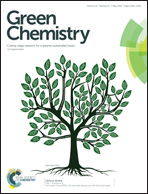Mild chemical pretreatments are sufficient for bioethanol production in transgenic rice straws overproducing glucosidase†
Abstract
Rice is a major food crop containing large amounts of lignocellulose residues usable for biofuels. In this study, we collected transgenic rice plants that over-produced Trichoderma reesei β-1,4-D-glucosidase (BGL I) into the cell walls in the mature straws. Without any pretreatment, the transgenic rice straws showed a consistently higher biomass enzymatic saccharification than the wild-type (WT) cultivar, in particular when 1% Tween-80 or 0.5% PEG-4000 was co-supplied into the enzymatic hydrolysis. Notably, under mild alkali pretreatment (1% NaOH at 50 °C for 2 h), the desirable transgenic line exhibited complete biomass enzymatic hydrolysis, resulting in the highest bioethanol yield of 21% (% dry matter) when compared with the rice and other bioenergy crops subjected to stronger pretreatment conditions reported in previous studies. Meanwhile, despite relatively low hexose yields obtained under 1% H2SO4 pretreatment, the transgenic rice straw also showed high bioethanol production at 18% due to an almost complete sugar–ethanol conversion rate. Chemical analyses indicated that the transgenic rice straw had significantly increased biomass porosity and reduced cellulose features (CrI, DP), which contributed to the largely enhanced biomass enzymatic hydrolysis. In addition, the raised arabinose level in hemicellulose and the lignin H-monomer proportion may also positively affect the biomass enzymatic saccharification in the transgenic rice straw. Hence, this study demonstrated a cost-effective and green lignocellulose conversion technology for high bioethanol production in the transgenic rice straw. It also provided a strategy for the potential genetic modification of plant cell walls in bioenergy crops.



 Please wait while we load your content...
Please wait while we load your content...